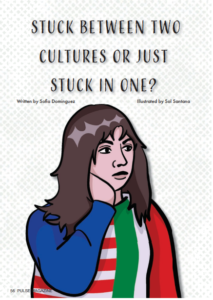Top 5 Filipino Monsters
If you were to walk into any store right now, you will find fall-themed decorations, an abundance of plastic jack-o-lantern buckets, a plethora of cheap costumes and a wide variety of candy for half the price. This, of course, can mean only one thing: Halloween is coming. Often, there are certain images we associate with Halloween. There are witches with black cats on broomsticks, there is a bubbling cauldron filled with mysterious potions, werewolves who howl at the moon or vampires who can turn into bats. Movies are often filled with ghouls, curses and other horrifying creatures of one’s imaginations. To spice up this Halloween, I wanted to share some monsters and ghouls from my own culture.
In the Philippines, there are many types of myths and legends, all varying in the different regions. Putting the subtle differences aside, there are some of the most common Filipino monsters that are known throughout the country. Perhaps these may serve as inspiration for new costumes, a new scary story to tell under the light of a flashlight or simply to expand one’s knowledge on the supernatural.
- Duwende
What is the image that comes to mind when you hear the word dwarf? Maybe it is one of the seven dwarves or maybe the dwarves from Lord of the Rings. In the Philippines, the duwende is a creature that is similar to a dwarf. There are some variations in appearance such as having “one eye in the middle of the forehead and large nose with a single nostril,” according to Emeterio C. Cruz in the 1933 Philippine Magazine XIXX, but generally the creature is often described as an old man with the height of a small child. Unlike the more friendly dwarves, such as Happy, the duwende would more accurately fit the description of Angry. Used to make smaller children behave, these mythological creatures are often depicted as living in an anthill, surrounded by precious gems and gold. They are commonly known for cursing someone who has hurt or offended them with unusual diseases that cannot be cured. Plates of food would be offered in hopes of gaining forgiveness. This is where the term “tabi tabi po,” which translates to “please move aside,” to serve as a warning for the duwende to not accidentally step on one. On the opposite side of the spectrum, there have also been stories in which duwendes are capable of acts of goodness and managing to befriend one would lead to a successful life. So, be extra careful where you step, for you might make a friend or a foe.
- Kapre
Where the duwende is small, the kapre is very large. Nearly 8 feet tall, it is said to be a mixture of human and ape. Often depicted with long black or brown hair, tree trunk-like legs, long fingers, sharp teeth and eyes that imitate the glow of a burning cigar. Notably, these mythical beings are said to live in giant trees while smoking cigars, drinking and gambling. Not very violent, many stories tell the tales of kapres playing pranks on travelers by stealing a bit of their memory so they cannot find their way home or stealing someone’s bed and putting it in a tree while the occupant is asleep. An endearing but also terrifying fun fact about the kapre is that these creatures are often seen as hopelessly romantic. There have been many stories involving them falling in love with human women, following them for the rest of their life and not letting anyone else have them. In extreme cases, they sometimes abduct these women and become violently jealous lovers. They are said to get so jealous that any potential suitors that court the women of their affections will often find themselves in a series of unfortunate events. Like the duwende, there are precautions one can take to avoid getting in trouble. Wearing a shirt inside-out while walking through the forest is said to prevent memory loss, while asking permission before passing underneath a tree serves as a warning to the kapre and avoiding its wrath.
- Tikbalang
So, to anyone who read the Percy Jackson series, do you guys remember Chiron? He was a wise centaur who served as a mentor to the demigods based on Greek mythology. Centaurs, according to Greek mythology, are said to have the torso of a man and the body of a horse. The depictions of centaurs vary, mostly seen as lustful and wild but some are wise and calm. Well, imagine if the centaur has a wildly unpopular cousin… twice removed. This would be the tikbalang.
The tikbalang is basically a reverse of the centaur, with having the head of a horse while having the body of a human but then having horse hooves as feet. Often found lurking in the mountains and forests, many like to scare travelers and lead them astray, which seems to be a common theme among these mythical beings. I guess they didn’t like visitors… but something interesting about the tikbalang is the ability to tame this creature. If one can obtain a hair from its mane, then it will become a loyal servant.
- Manananggal
The manananggal is one of the creepier myths in Filipino folklore. The name itself comes from the word tanngel, which translates to separator. The creature is described to have wide eyes, wild hair, fangs and long, sharp claws but the legend tells the tale of a beautiful woman. It is the same woman who turns into a winged creature who can separate from its body at night and hunts for pregnant women to eat their unborn babies by using its extremely long tongue. The transformation itself is a bit of a process. First, the beautiful woman sneaks out of her home at night and hides in the bushes or a groove of banana trees. She then rubs her body with a special oil and a few minutes later, bat wings sprout on her back and her torso separates from her legs. The top half will go look for something to eat while the legs stay behind.
Fear not, these creatures are not invincible. Since the legs are left behind, this becomes a point of vulnerability. It is said the best way to kill the creature is to wait for the body to separate and then sprinkle salt or crushed garlic on the lower half, making the manananggal unable to rejoin and be whole. If this happens, then it will die when the sun rises because, like a vampire, the creature will not survive in sunlight when it is not in its human form. Some households used to put pots of uncooked rice, ash or salt around the vicinity because they said that if the manananggal saw the items from the roof, then it will decide whether to enter. Personally, this is the creature that used to scare me the most as a child because of the visual image of a lady with wings and fangs, while the intestines and other organs hang out, flying through the sky was quite disturbing. Now that I’m older, the folklore is still terrifying but oddly intriguing at the same time.
- Aswang
The aswang is a shapeshifting monster similar to the manananggal because it likes to appear as a normal person by day and shapeshifts to feast on people during the night. During the day, they are not beautiful women, rather just everyday folk with friends, families and jobs. They are even said to appear as shy and reclusive, so they don’t attract too much attention. By night however, it likes to take the form of different animals, such as a bird, a pig or a dog. There is a distinct difference between the aswang and the manananggal where it does not separate from its body. This allows for it to blend in, even at night, but there are some terrifying characteristics it has compared to its normal counterparts. It will have very long tongues, often described as walking with their feet backwards and being as thin as bamboo posts.
Its shapeshifting abilities can extend beyond itself as it is known that aswangs can transform plants into other objects, usually into doppelgangers of one of its victims to hide the evidence from the locals. These doppelgangers can replace a living person or the corpses of that person. Replacing a living person, the doppelganger will return to that person’s home, get sick and eventually die.
The transformation, like the manananggal, requires a sort-of ritual. A person transforms into an aswang by tying a fertilized chicken egg to their stomach and allowing the chick to pass from the egg, into the stomach. The remaining eggshell is buried in a bamboo tube with coconut oil and chicken dung. This is no Sailor Moon transformation, though I suppose it is a good thing since less people would be willing to try it out. Unless of course, fertilized chicken eggs and chicken dung is not a problem, then we may have a potential problem on our hands.
This creature is not invincible either. If a dragon can be slain by a sword, the aswang is slain by decapitation or being whipped by a sting ray’s tail. Less accessible but more creative if someone is looking to spice things up. Salt, garlic and ginger are said to repel these creatures as well as religious artifacts placed near windows. This can both be holy water or Philippine amulets, depending on the time period and region.
Admittedly, these creatures may be weird and disturbing to many, especially those who are not used to hearing folklore like these, but it shows the variety and uniqueness each culture has to offer; that Halloween can be more than spooky skeletons, ghosts and ghouls. That there is more than what is typically associated with the commercialized Halloween holiday and perhaps can be a chance to learn some interesting, albeit, terrifying folklore and mythologies of other countries. We can’t go out this Halloween, but that does not mean it should be any less exciting. Try new things and maybe you’ll find something you like... Just be careful of what you might find.








